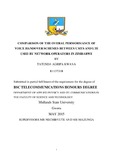Please use this identifier to cite or link to this item:
https://cris.library.msu.ac.zw//handle/11408/2798Full metadata record
| DC Field | Value | Language |
|---|---|---|
| dc.contributor.author | Kwava, Tatenda Agripa | - |
| dc.date.accessioned | 2017-09-04T15:29:41Z | - |
| dc.date.available | 2017-09-04T15:29:41Z | - |
| dc.date.issued | 2015 | - |
| dc.identifier.uri | http://hdl.handle.net/11408/2798 | - |
| dc.description.abstract | The main objective of mobile operators is to enable mobile users to stay connected while roaming across heterogeneous networks. As cellular networks evolve from the third generation Universal Mobile Telecommunication System (UMTS) to the Long Term Evolution (LTE), a new Evolved Packet Core (EPC) will support heterogeneous radio access networks on the same platform. UMTS provides voice services in the circuit switched domain; while LTE operates in the packet switched domain. Cellular network operators in Zimbabwe faced the challenge of providing voice services during initial deployment of LTE due to difficulty in mobility between the two domains. Seamless voice handover between packet switched LTE and the circuit switched UMTS network is therefore an important tool in solving this problem. | en_US |
| dc.language.iso | en | en_US |
| dc.publisher | Midlands State University | en_US |
| dc.subject | Mobile networks | en_US |
| dc.subject | Telecommunication systems | en_US |
| dc.title | Comparison of the overall performance of voice handover schemes between UMTS and LTE used by network operators in Zimbabwe | en_US |
| item.fulltext | With Fulltext | - |
| item.grantfulltext | open | - |
| item.languageiso639-1 | en | - |
| Appears in Collections: | Bsc Telecomunications Honours Degree | |
Files in This Item:
| File | Description | Size | Format | |
|---|---|---|---|---|
| tatenda risho kwava.pdf | Full Text | 2.93 MB | Adobe PDF |  View/Open |
Page view(s)
130
checked on Oct 24, 2025
Download(s)
62
checked on Oct 24, 2025
Google ScholarTM
Check
Items in MSUIR are protected by copyright, with all rights reserved, unless otherwise indicated.



